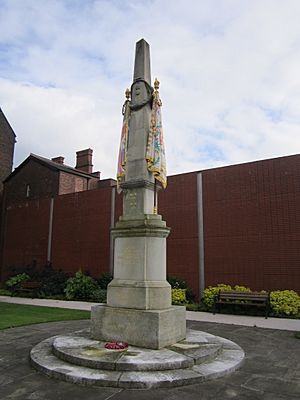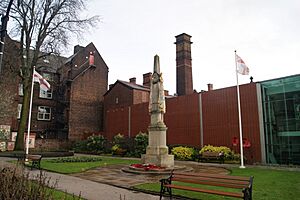Lancashire Fusiliers War Memorial facts for kids
Quick facts for kids Lancashire Fusiliers War Memorial |
|
|---|---|
| England | |
 |
|
| For men of the Lancashire Fusiliers killed in the First World War | |
| Unveiled | 25 April 1922 |
| Location | 53°35′32″N 2°17′55″W / 53.59226°N 2.29872°W Gallipoli Gardens, Bury, Greater Manchester
|
| Designed by | Sir Edwin Lutyens |
|
Listed Building – Grade II
|
|
| Official name | War Memorial to the Lancashire Fusiliers, Gallipoli Gardens |
| Designated | 2 September 1992 |
| Reference no. | 1250814 |
The Lancashire Fusiliers War Memorial is a special monument in Bury, Greater Manchester, England. It remembers the brave soldiers of the Lancashire Fusiliers who died in the First World War. The memorial stands outside the Fusilier Museum in a place called Gallipoli Gardens.
It was first shown to the public on April 25, 1922. This date was chosen because it was exactly seven years after a very important battle called the landing at Cape Helles. This battle was part of the Gallipoli Campaign, where many soldiers from the Lancashire Fusiliers lost their lives. The memorial was designed by a famous architect named Sir Edwin Lutyens. His family had a special connection to the regiment, which is why he designed it.
The memorial is a tall, thin stone pillar made of Portland stone. Near the top, it has the regiment's cap badge carved into it, surrounded by a laurel wreath. Below that, there are words like the regiment's motto. Two painted stone flags hang from the sides. Over the years, the memorial has been moved and rededicated to remember all fusiliers who died in battle. It is now a protected historical site.
Contents
Remembering the First World War
After the First World War, many memorials were built across Britain. This was because so many people had died in the war. One of the most important designers of these memorials was Sir Edwin Lutyens. He was known as a leading architect of his time.
Lutyens designed many buildings, but after the war, he spent a lot of time creating memorials. He became famous for designing The Cenotaph in London, which is Britain's national war memorial. He also worked on memorials for towns, cities, and army groups. The Lancashire Fusiliers memorial was one of these special projects.
Lutyens had a personal reason for designing this memorial. His father and great uncle were both officers in the Lancashire Fusiliers. Because of this family connection, Lutyens designed the memorial for free. His great uncle, Major Engelbert Lutyens, even guarded Napoleon Bonaparte during his exile!
The Lancashire Fusiliers was a large army regiment. Thousands of volunteers joined during the First World War. Many joined with friends and neighbours in groups called "pals battalions." By the end of the war, the regiment had grown to 30 different groups of soldiers.
One of their most famous actions was at the landing at Cape Helles on April 25, 1915. This was part of the Gallipoli Campaign in Turkey. During this battle, members of the 1st Battalion famously earned "six Victoria Crosses before breakfast." A Victoria Cross is the highest award for bravery in the British military. The beach where they landed was later named "Lancashire Landing."
Why the Memorial Was Built
By the end of the First World War, 13,642 Lancashire Fusiliers had been killed. About 600 of them died at Cape Helles alone. The regiment earned 18 Victoria Crosses in total, more than any other infantry regiment. These huge losses deeply affected the local community, especially in Bury, where the regiment was based.
Every year since 1916, a ceremony has been held in the local church to remember the Cape Helles landing. The church also has a special tablet placed by the crew of HMS Euryalus. This ship carried many of the soldiers to Gallipoli.
Because so many soldiers had died, people felt strongly that their efforts should be remembered. In 1919, a committee was formed to raise money for a permanent memorial and a fund to help soldiers and their families. Lutyens visited Bury in 1920 and agreed to design the memorial. He chose a spot outside the regiment's main building, Wellington Barracks.
What the Memorial Looks Like
The memorial was built by a local stonemason from Bury. It is a single, tall, tapering pillar made of Portland stone. It stands on a square base.
On the front and back of the pillar, there are carvings of the Lancashire Fusiliers' cap badge. Below the badge, the regiment's motto, OMNIA AUDAX (which means "daring in all things"), is written. On each side of the pillar, there are carved and painted flags.
The pillar itself is about 4 meters (13 feet) tall. The whole memorial, from top to bottom, is about 6.9 meters (23 feet) tall.
Other words are carved on the lower part of the memorial. The dates of the First World War are there, along with a dedication: TO THE LANCASHIRE FUSILIERS THEIR DEEDS AND SACRIFICES FOR KING AND COUNTRY. Later, after the Second World War, more words were added to remember those who died then and in other conflicts.
History of the Memorial

The memorial was officially shown to the public by Lieutenant General Sir Henry de Beauvoir De Lisle on April 25, 1922. This was the seventh anniversary of the Cape Helles landing. The general gave a speech about the bravery of the soldiers and the "six Victoria Crosses before breakfast." He unveiled the memorial by pressing an electric button, which was a new way to do it back then.
Even though Lutyens couldn't be there, he sent a message. Other important people attended, including local mayors and Captain Richard Raymond Willis, who was one of the soldiers who earned a Victoria Cross at Gallipoli. Money left over from building the memorial was used to buy drums and bugles for the regiment. These instruments were played at the ceremony and are now in the Fusilier Museum.
The memorial first stood outside the regiment's headquarters at Wellington Barracks for over 40 years. But when the barracks closed in the 1970s, the memorial was moved. In 2009, it was moved again to its current spot in Gallipoli Gardens, next to the Fusilier Museum. Lutyens' grandson, Lord Ridley, helped unveil it in its new home.
In 1968, the Lancashire Fusiliers regiment joined with other regiments to form the Royal Regiment of Fusiliers. The new regiment adopted the memorial and rededicated it. Now, it remembers all fusiliers who have died while serving their country.
The Lancashire Fusiliers memorial was given special protection as a "grade II listed building" in 1992. This means it's an important historical building. In 2015, it was upgraded to "grade II*," which means it's even more important. This upgrade happened on the 100th anniversary of the Gallipoli landings. This status helps protect the memorial from being changed or taken down.
Images for kids




